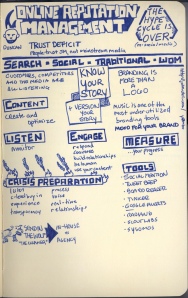Online Marketing
Moving Day. Come with Me and Come Back.

This Blog is Moving and Will Now Be Known as 'the inbound-i blog'. Click the link and come subscribe for uninterrupted service. I'll miss you if you don't!
Dear Subscribers,
Today is moving day. I’m launching a new blog called ‘the inbound-i blog’. It’s a continuation and evolution of New PR Words and Music, which will remain here so that you can come back and access the 110 posts created here. When you click on the link to the new blog and read the first post, you’ll understand why I’m making the change.
While you’re there, please subscribe by email or RSS feed so that you receive the latest information, ideas and intelligence about inbound marketing without interruption.
The new blog is a result of the evolution of online marketing and my own business focus. In explaining why the new blog, there’s also some good information for you about the importance of tailoring your online marketing to maximize the use of inbound marketing analytics.
Come with me to the new blog for future posts and come back here as often as you like to re-read and to re-listen to your musical favorites.
I will, too.
The moving image is from the Flickr photostream of aldenjewell under Creative Commons license.
Read Full Post | Make a Comment ( None so far )Proof: Hot Topics Can Get Posts to Google Page 1
My last post has made it to Google Page 1 for searches related to the Kim Kardashian divorce – the intended point of an experiment I conducted with it. See above and below for the proof.
The post contended that including hot and trending topics in your blog posts can boost your traffic by getting your post to come up in more searches. As an experiment I created an Inbound Marketing metaphor to the Kim Kardashian Kris Humphries Divorce.
The post also referenced Siri, which had brought another of my posts to Google Page 1 for sumerous searches and led to the topic of the last post and the Kardashian experiment. Here are more results.
The searches are actual searches that got people to my blog. Note that the first Page 1 positions were out of 165,000,000 results and the second was out of 7,030,000 results. Case made. Hot topics can get you visibility you’d never get otherwise!
What trending topics and current events will you tie your next post to?
Read Full Post | Make a Comment ( 1 so far )Proud to Be Googled
If we’re marketing online, then I think the goal should be simple. We should strive to always be proud to be googled. After awhile of building an online presence, we have bios and profiles posted all over the web.
Not only that, somewhere our tweets live on – even if Google isn’t indexing them anymore. Wherever we’ve commented on blogs, it’s there to be served up in response to simple queries that include our names, our urls, our companies and any other identifiers or keywords that pull up something we’ve posted or contributed to online.
The fun of marketing online – and what keeps me writing blog posts at the end of the work-a-day – is that you never know where what you put into the cyber world will end up. It’s exciting!
The whole history of my career in PR and online marketing is on the Web. Press releases for clients. Milestones in my agency. Columns I write. Blog posts. Comments here and there. Guest posts. Media coverage.
It doesn’t matter one iota what I say about myself. Everything I’ve done is there to be found, there to be seen by anyone who types my name or company name into a search field. It provides credibility. She says she writes columns? Oh yes. There’s her column.
Whenever I post something online, I say to myself, “If I tell someone to google me and this comes up in the SERPs, how will I feel about it? What will it say about me to someone who doesn’t know me and is thinking of hiring me?”
My clients and I are building our businesses on the web. None of us is perfect and we may all exercise an occasional lack of judgment about something we post. It can happen.
But why not build our online personae in a way that is both authentic and that we can be proud of…that we can say, “Here’s my bio, but if you want the bigger picture, google me!”
By the way…follow the link if you’re interested in how Inbound Marketing can generate online leads.
The image is by y0mbo under Creative Commons license.
Read Full Post | Make a Comment ( 6 so far )A Marketing View: 20 Steps to a Website that Maximizes Business Growth
In the past, if you wanted a new website – or to redesign an existing one – the first step was to find a web design firm. This was fine when your website was an online brochure.
Today, if you make your first concern the design and look/feel of your site, you’re missing valuable opportunities to use the web project to refine or redefine your business focus, to add new business lines – and to get found.
A marketing/business consultant is well suited to help you in this effort and is a prudent first stop. Getting an outside eye on your business and online marketing can yield fresh ideas about how you can use your web presence to grow.
Then find a good design/web development firm capable of implementing your brand identity and web strategy, offering technical advice, and organizing your content for usability. Your marketing consultant will undoubtedly be able to help you source the right partner.
Here are 20 steps to structuring a website project to maximize business growth:
1. Review and audit your current marketing, as well as new marketing approaches you’d like to add.
2. Be able to articulate, “What’s our business?”
3. Do a lot of competitive research. Look at other sites. See what your competitors are doing or not doing. A good consultant will come up with ways that you can leap-frog them with your expanded web presence. (Tip: SEO utilizing current best practices provides fertile soil for growth. Most businesses simply aren’t doing it, or doing it right.)
4. Be sure to answer the question: “Are there any new products, services or offerings related to our core business that we can and should add?”
5. Make sure you’re focused on the right customer.
6. Identify your market positioning.
7. Think out of the box to identify all stakeholders and key influencers.
8. Interview a few of them
9. Develop your key messages – the most important ideas you want to convey consistently to your audiences.
10. Do your keyword research – identify the words/phrases people are actually using to search on line for products/services like yours. (Hint: Not necessarily the words you’d use to search for them).
11. Organize your site by developing a sample navigation. Be sure to include a blog if you want to drive maximum traffic to your site. Have your consultant recommend internal linking strategies to help users work efficiently through your site.
12. Decide: What existing content can be re-used? What content should be scrapped? What new pages do you need to develop?
13. Determine the level of control you want or need to have over your website. What edits do you want to be able to make in-house without tech assistance. We recommend having as much control as possible if you want to use your website to help grow your business.
14. Source a web designer/developer who works in technology platforms that will accommodate the level of control you desire.
15. Provide the navigation and all the guidance you’ve developed in completing the steps above to your web developer. It will help them prepare a realistic budget.
16. Write/develop the content for all of your pages – including all SEO information for each page, any photos, videos and other media you’ll want to use – and provide the content to the web developer.
17. Get into the design process and have fun with the visual.
18. Code the site in accordance with the provided SEO, content and linking strategies. In the case of website re-do’s, make sure to properly re-direct existing pages and to retain important backlinks to the site.
19. Test and tweak for usability.
20. LAUNCH!!
Emphasizing business and marketing strategy first in the web development process has never failed to yield new directions for our clients’ businesses.
The illustration “Dollar Sign in Space” is by DonkeyHotey under Creative Commons license.
Read Full Post | Make a Comment ( None so far )Lessons from the 2011 Inbound Marketing Summit
My Twitter account was hacked last night, so no Tuesday Tweets til I get things back to normal. Instead, I’ll share more learning from the 2011 Inbound Marketing Summit (#IMS11 if you want to follow it on Twitter), which I attended last week in Boston.
I put up a couple of quick posts while I was there, but now that I’ve had a chance to process the experience and review my notes I can offer you more in depth reporting and some key takeaways.
As in the past two years that I’ve attended, the speakers were the top names in marketing and media – online and offline. I’ll be sharing highlights of their talks over the next week or so – starting now.
Differentiating Your Company from the Competition
After a welcome by Massachusetts Governor Deval Patrick, who talked about the opportunities for tech companies in his state, Harvard Business School professor Youngme Moon gave the opening keynote on the topic of marketing differentiation. This is a favorite topic of mine as I see so much boring sameness out there, industry to industry. Translate that to mean loss of opportunity.
In true HBS tradition, as she put it, Moon explained ‘being different’ via case studies of IKEA, Mini Cooper and Apple. These ‘different’ companies have built very devoted customers and share certain qualities that we can all try to emulate:
- Nurturing the seemingly crazy ideas that lead them to buck the status quo and become ‘different.’ (Think about launching a tiny car to the U.S. market in an age of SUVs.)
- Embracing their negatives. According to Moon, the genius is often in the negatives.
- Being willing to ignore critics.
- Not over-listening to customers, who can tell you how to improve, but not how to be different.
- Being passionate beyond belief – the extreme version of caring and believing.
Do You Really Need to Be On Google+?
Chris Brogan, who’s been evaluating Google+ in depth since it launched in June tackled the subject of why we need another social network. His answer: Technology Evolves! We need to go where our people are.
Brogan pointed out an array of now-defunct – or almost defunct – technology and sites to make his point. Do you remember Friendster? Does anyone log onto Geocities these days?
Beyond its ‘clean’ visual look, Google+ has added social functionalities that have been missing and that Twitter and Facebook have now responded to with similar features. Selective sharing has been embraced, along with the video conferencing capabilities of which people are making varied and creative use, i.e. holding intellectual ‘salons’ of gurus and regular folk or hosting international customer support forums.
But the most powerful reason to have a Google+ presence is that it’s the first social network that combines social with search. Google no longer indexes Twitter, but being on Google+ might just help you come up higher in organic search results than those who aren’t.
Middle of the Sales Funnel in the Spotlight
HubSpot co-founder and CEO Brian Halligan used his speaking slot to address the shifting sales funnel. The first few years of inbound marketing have focused on stretching the top of the sales funnel by attracting more traffic to our websites and other online outposts and then converting the traffic to leads.
Inbound marketing 2.0 will be about how to better nurture leads through the middle of the sales funnel so that we develop a significant enough relationship to convert leads to customers when they’re ready to purchase. HubSpot recently acquired the company Performable, which has focused on middle-of-the-funnel technology that will now integrate with the HubSpot platform.
The key takeaway from Brian’s talk is that this shift in focus to the middle of the funnel coincides with the shift in power from the sales rep to the buyer created by the ability to research products and services online before buying. This has created a paradigm shift in the relationship between marketing and sales.
The new realities of buyer power require bigger marketing departments to handle the lead generation and nurturing processes and a smaller sales force that can concentrate on converting to customers the highly-qualified and sales-ready leads that marketing turns over to them.
More to come! Have you begun shifting your marketing to take advantage of new thinking and online tools?
Read Full Post | Make a Comment ( 1 so far )Report #2 from Inbound Marketing Summit
How much better does it get for online marketing geeks? Former Apple chief evangelist and author Guy Kawasaki spoke about his book Enchantment this morning. His updated take on How to Win Friends and Influence People gives a fresh take on how to connect offline as well as online in a digital world. He definitely models his first premise: Be Likable!
The day ended with Fast Company writer Dan Heath offering wisdom from his NY Times bestseller Switch: How to Change Things When Change is Hard. Perfect for inbound marketers who are working to change marketing so that it works for today’s realities.
Between the two talks HubSpot founder and CEO Brian Halligan updated us VARs on the direction the company is taking to help companies embrace the changes in the way they must market to be successful.
Let me share with you that it’s such exciting stuff. Successful marketing has never been easy or without sufficient investment.
At least now, you can finally see the results of your marketing investment – of dollars and time – in concrete terms. More than ever before you can integrate your efforts for great efficiency and with maximum control.
When I get back to the office I’ll share more specifics. Just thought I’d give you a small rundown and a bit of the day’s energy.
Read Full Post | Make a Comment ( 2 so far )Competition and Other Annoying Business Realities
The Dow fell more than 500 points today. Bad news was exuding from every media outlet. I had an opportunity to get some perspective on it in my weekly networking group meeting from members who are highly sophisticated financial experts.
Then I came home, shared some conversation with my neighbor on her garden swing, pulled a bunch of weeds that have been bothering me while thinkingabout what my blog topic would be for today. Relaxing and getting still allowed me to realize what was concerning me – and probably you, too.
When markets go crazy and economies are shaky and there’s less business to go around, we can’t help but think about how we’ll compete for what business there is. This has been on my mind for some time and brought to the forefront by today’s events.
Bottom line, I’ve decided not to worry about who else is competing for a piece of the online/inbound marketing pie. Instead, I’m working on my own story. Thinking harder about what I bring to the table that will have value for my clients and that I can speak powerfully about to prospects. I’m thinking about my strengths – what I really do better than anyone I’ve encountered.
Then I’m evaluating my lighter abilities — what I fully understand but need partners to execute well.
And I’m working on my messaging so that I can communicate clearly and effectively. That includes listening and testing… talking to as many people as I can find who are willing to offer feedback as I hone my messages.
I’m asking myself:
- Are my offerings aligned with the needs of my client/prospect?
- Is my language completely understandable, or too jargon-y?
- Am I creating enough curiosity that people will be willing to stick around and learn more?
- Am I explaining my services so that the benefits and value come through loud and clear?
- Am I being human enough to connect and credible enough to build trust?
I believe that refocusing my energies on being as meaningful as possible to my market is my competitive edge.
How are you dealing with the competitive and business realities of the current economic environment?
Image from tableatny under Creative Commons license.
Read Full Post | Make a Comment ( 2 so far )« Previous Entries









